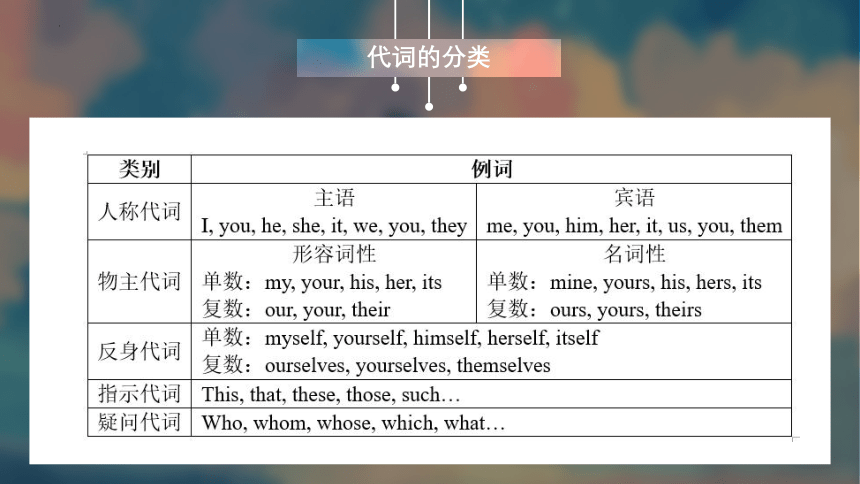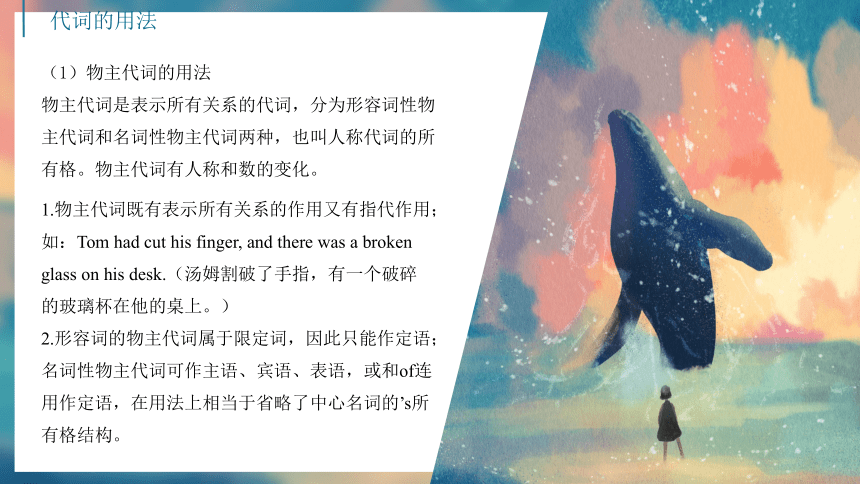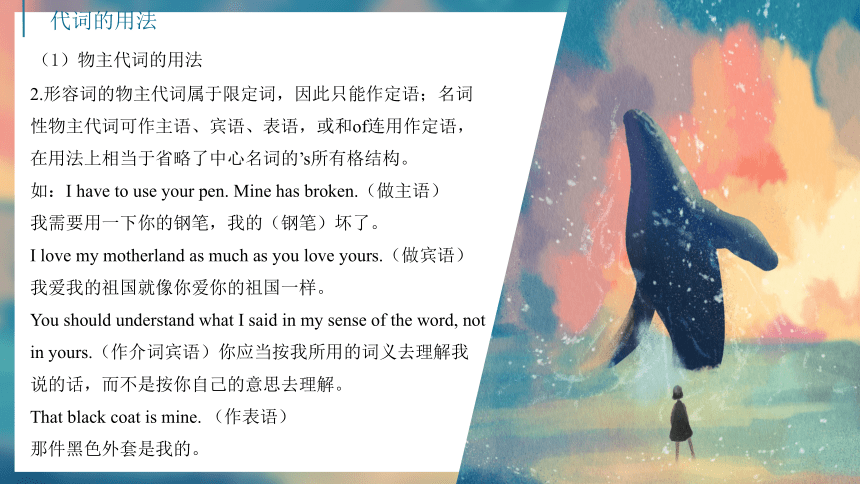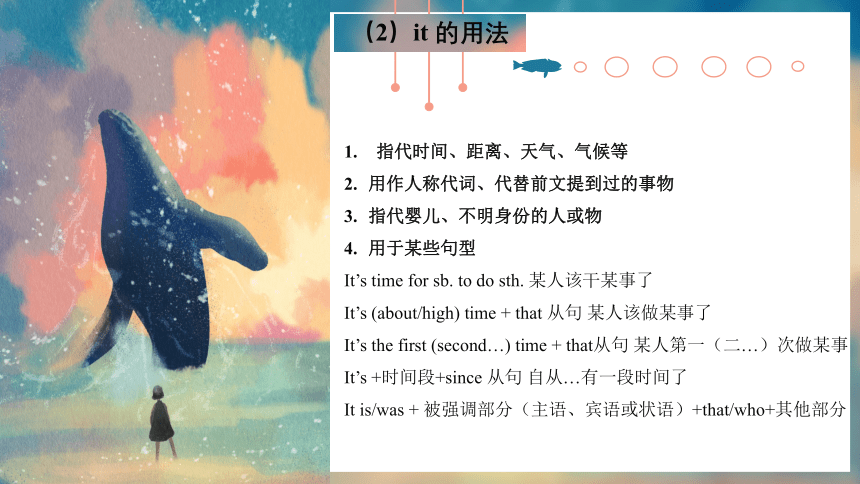2023届高考英语二轮复习代词专项讲解课件(18张PPT)
文档属性
| 名称 | 2023届高考英语二轮复习代词专项讲解课件(18张PPT) |  | |
| 格式 | pptx | ||
| 文件大小 | 3.1MB | ||
| 资源类型 | 教案 | ||
| 版本资源 | 通用版 | ||
| 科目 | 英语 | ||
| 更新时间 | 2023-02-04 08:34:12 | ||
图片预览







文档简介
(共18张PPT)
代词
什么是代词
代词就是代替名词的词,主要是为了避免名词的重复。根据代词表达的意义和用法。
代词的分类
代词的分类
代词的用法
(1)物主代词的用法
物主代词是表示所有关系的代词,分为形容词性物主代词和名词性物主代词两种,也叫人称代词的所有格。物主代词有人称和数的变化。
1.物主代词既有表示所有关系的作用又有指代作用;
如:Tom had cut his finger, and there was a broken glass on his desk.(汤姆割破了手指,有一个破碎的玻璃杯在他的桌上。)
2.形容词的物主代词属于限定词,因此只能作定语;名词性物主代词可作主语、宾语、表语,或和of连用作定语,在用法上相当于省略了中心名词的’s所有格结构。
代词的用法
(1)物主代词的用法
2.形容词的物主代词属于限定词,因此只能作定语;名词性物主代词可作主语、宾语、表语,或和of连用作定语,在用法上相当于省略了中心名词的’s所有格结构。
如:I have to use your pen. Mine has broken.(做主语)
我需要用一下你的钢笔,我的(钢笔)坏了。
I love my motherland as much as you love yours.(做宾语)
我爱我的祖国就像你爱你的祖国一样。
You should understand what I said in my sense of the word, not in yours.(作介词宾语)你应当按我所用的词义去理解我说的话,而不是按你自己的意思去理解。
That black coat is mine. (作表语)
那件黑色外套是我的。
(2)it 的用法
指代时间、距离、天气、气候等
用作人称代词、代替前文提到过的事物
指代婴儿、不明身份的人或物
用于某些句型
It’s time for sb. to do sth. 某人该干某事了
It’s (about/high) time + that 从句 某人该做某事了
It’s the first (second…) time + that从句 某人第一(二…)次做某事
It’s +时间段+since 从句 自从…有一段时间了
It is/was + 被强调部分(主语、宾语或状语)+that/who+其他部分
(2)it 的用法
5. 作形式主语
It + be + adj. (for/of sb.) to do sth. 某人做某事是…
It takes sb. + 一段时间+ to do sth. 某人做某事花了…时间
It is up to sb. to do sth. 由某人决定做某事
6. 作形式宾语
动词+ it + that从句
动词+ it+ when (if)从句
动词+ prep. + it+ that从句
动词+ it +介词短语+ that从句
动词+ it+ adj. (for sb.) to do sth.
(3)不定代词的用法
①few, little, a few, a little的用法
few和little表示没有多少,含否定意义;
a few 和a lite表示有一些、 有几个,含肯定意义。
另外,few和a few修饰可数名词,little 和a little修饰不可数名词。它们在句中常作定语、主语和宾语。
如:He knows a little English. (定语)
Few of them could speak English.(主语)
I know little about Japanese. (宾语)
(3)不定代词的用法
②other, the other, another的用法
a. other泛指“另外的”,作定语,常与复数名词或不可数名词连用;但如果前面有the, this, that, some, any, each, every, no, none, one及形容词性物主代词,则可与单数名词连用。如other boys, the other one, any other plant, every other day, some other reason等
如:My other sister is a doctor.
(3)不定代词的用法
②other, the other, another的用法
b. the other指“两者中的另一个”时,常与one构成one ...the other ..作定语修饰复数名词时, 表示一定范围内“所有其余的人或物”。
如:He held a book in one hand and his notes in the other.
注意:others是other的复数形式,泛指“别的人或物”(但不是全部) ;the others是the other的复数形式,特指“其余全部的人或物”。
如: Some are carrying water, and others are watering the trees.
I have got ten pencils. Two of them are red, and the others are blue.
(3)不定代词的用法
②other, the other, another的用法
c. another指三个或三个以上中的“任何一个”“再一...“另一个”。
如:I have finished this novel. Please give me another.
(3)不定代词的用法
③one .. the other和one .. another的区别
one...the other指两个人或物构成的一组中的个体;one ...other指不确定范围中的两个个体。
如:
Here are two books. One is for Mary, and the other is for Jack.
One person may like to spend his holiday at the seashore, while another may prefer the mountains.
(3)不定代词的用法
④all和both的用法
all和both都表示整体,但both指两个人或物,而all指三个或三个以上的人或物;在句中都可作主语、表语、宾语、同位语和定语。
如:All of us should work hard. (主语)
That is all for today.(表语)
We like both of the books.(宾语)
We both like to go.(同位语)
注意:
a. all表示不可数名词时,其谓语动词用单数。
b. both和all加否定词是部分否定,如果要表示全部否定,分别用neither和none。
如:Both of us are not teachers. (部分否定)我们俩不都是老师。
Neither of us is a teacher.(全部否定)我们俩都不是老师。
(3)不定代词的用法
⑤neither和either的用法
neither表示两者都不,either 表示两者中的任何一个;在句中可作主语、宾语和定语。
如:
Neither of the answers is wrong.(主语)
You may take either of the books. (宾语)
Either sentence is right. (定语)
(3)不定代词的用法
⑥one的用法:
one指代前面提到的可数名词中的一个,相当于“a(n) +名词”。one既可指代人,也可指代物;ones是one的复数形式,指代复数名词;the one用来代替前面特指的单数名词,有时可用that代替。
如:A dress made of silk costs more than one made of cotton.
丝绸做的裙子比棉做的裙子要贵。
Eastern Europe shows that worker-owned factories can be as inefficient as state-owned ones.
东欧的经验表明,工人所有的工厂可能和国有工厂一样效率低下。
The book on the desk is better than the one in his hand.
桌上的这本书比他手里的那本好
知识拓展:one, that和it的区别
one表示泛指,that和it表示特指。
如:
I can’t find my hat. I think I must buy one.(不定)
我找不到我的帽子了,我想我该去买一顶。The hat you bought is bigger than that(同类不同物)
你买的那顶帽子比我买的大。can t find my hat. I don’t know where I put it. (同一 物)
我找不到我的帽子了,我不知道把它放哪了。
知识拓展:half的用法
half可以作代词,其前一般不用定冠词,其后可以直接跟名词,也可以跟of短语。
如:
Half (of) the fruit was bad.水果坏了一半。
代词
什么是代词
代词就是代替名词的词,主要是为了避免名词的重复。根据代词表达的意义和用法。
代词的分类
代词的分类
代词的用法
(1)物主代词的用法
物主代词是表示所有关系的代词,分为形容词性物主代词和名词性物主代词两种,也叫人称代词的所有格。物主代词有人称和数的变化。
1.物主代词既有表示所有关系的作用又有指代作用;
如:Tom had cut his finger, and there was a broken glass on his desk.(汤姆割破了手指,有一个破碎的玻璃杯在他的桌上。)
2.形容词的物主代词属于限定词,因此只能作定语;名词性物主代词可作主语、宾语、表语,或和of连用作定语,在用法上相当于省略了中心名词的’s所有格结构。
代词的用法
(1)物主代词的用法
2.形容词的物主代词属于限定词,因此只能作定语;名词性物主代词可作主语、宾语、表语,或和of连用作定语,在用法上相当于省略了中心名词的’s所有格结构。
如:I have to use your pen. Mine has broken.(做主语)
我需要用一下你的钢笔,我的(钢笔)坏了。
I love my motherland as much as you love yours.(做宾语)
我爱我的祖国就像你爱你的祖国一样。
You should understand what I said in my sense of the word, not in yours.(作介词宾语)你应当按我所用的词义去理解我说的话,而不是按你自己的意思去理解。
That black coat is mine. (作表语)
那件黑色外套是我的。
(2)it 的用法
指代时间、距离、天气、气候等
用作人称代词、代替前文提到过的事物
指代婴儿、不明身份的人或物
用于某些句型
It’s time for sb. to do sth. 某人该干某事了
It’s (about/high) time + that 从句 某人该做某事了
It’s the first (second…) time + that从句 某人第一(二…)次做某事
It’s +时间段+since 从句 自从…有一段时间了
It is/was + 被强调部分(主语、宾语或状语)+that/who+其他部分
(2)it 的用法
5. 作形式主语
It + be + adj. (for/of sb.) to do sth. 某人做某事是…
It takes sb. + 一段时间+ to do sth. 某人做某事花了…时间
It is up to sb. to do sth. 由某人决定做某事
6. 作形式宾语
动词+ it + that从句
动词+ it+ when (if)从句
动词+ prep. + it+ that从句
动词+ it +介词短语+ that从句
动词+ it+ adj. (for sb.) to do sth.
(3)不定代词的用法
①few, little, a few, a little的用法
few和little表示没有多少,含否定意义;
a few 和a lite表示有一些、 有几个,含肯定意义。
另外,few和a few修饰可数名词,little 和a little修饰不可数名词。它们在句中常作定语、主语和宾语。
如:He knows a little English. (定语)
Few of them could speak English.(主语)
I know little about Japanese. (宾语)
(3)不定代词的用法
②other, the other, another的用法
a. other泛指“另外的”,作定语,常与复数名词或不可数名词连用;但如果前面有the, this, that, some, any, each, every, no, none, one及形容词性物主代词,则可与单数名词连用。如other boys, the other one, any other plant, every other day, some other reason等
如:My other sister is a doctor.
(3)不定代词的用法
②other, the other, another的用法
b. the other指“两者中的另一个”时,常与one构成one ...the other ..作定语修饰复数名词时, 表示一定范围内“所有其余的人或物”。
如:He held a book in one hand and his notes in the other.
注意:others是other的复数形式,泛指“别的人或物”(但不是全部) ;the others是the other的复数形式,特指“其余全部的人或物”。
如: Some are carrying water, and others are watering the trees.
I have got ten pencils. Two of them are red, and the others are blue.
(3)不定代词的用法
②other, the other, another的用法
c. another指三个或三个以上中的“任何一个”“再一...“另一个”。
如:I have finished this novel. Please give me another.
(3)不定代词的用法
③one .. the other和one .. another的区别
one...the other指两个人或物构成的一组中的个体;one ...other指不确定范围中的两个个体。
如:
Here are two books. One is for Mary, and the other is for Jack.
One person may like to spend his holiday at the seashore, while another may prefer the mountains.
(3)不定代词的用法
④all和both的用法
all和both都表示整体,但both指两个人或物,而all指三个或三个以上的人或物;在句中都可作主语、表语、宾语、同位语和定语。
如:All of us should work hard. (主语)
That is all for today.(表语)
We like both of the books.(宾语)
We both like to go.(同位语)
注意:
a. all表示不可数名词时,其谓语动词用单数。
b. both和all加否定词是部分否定,如果要表示全部否定,分别用neither和none。
如:Both of us are not teachers. (部分否定)我们俩不都是老师。
Neither of us is a teacher.(全部否定)我们俩都不是老师。
(3)不定代词的用法
⑤neither和either的用法
neither表示两者都不,either 表示两者中的任何一个;在句中可作主语、宾语和定语。
如:
Neither of the answers is wrong.(主语)
You may take either of the books. (宾语)
Either sentence is right. (定语)
(3)不定代词的用法
⑥one的用法:
one指代前面提到的可数名词中的一个,相当于“a(n) +名词”。one既可指代人,也可指代物;ones是one的复数形式,指代复数名词;the one用来代替前面特指的单数名词,有时可用that代替。
如:A dress made of silk costs more than one made of cotton.
丝绸做的裙子比棉做的裙子要贵。
Eastern Europe shows that worker-owned factories can be as inefficient as state-owned ones.
东欧的经验表明,工人所有的工厂可能和国有工厂一样效率低下。
The book on the desk is better than the one in his hand.
桌上的这本书比他手里的那本好
知识拓展:one, that和it的区别
one表示泛指,that和it表示特指。
如:
I can’t find my hat. I think I must buy one.(不定)
我找不到我的帽子了,我想我该去买一顶。The hat you bought is bigger than that(同类不同物)
你买的那顶帽子比我买的大。can t find my hat. I don’t know where I put it. (同一 物)
我找不到我的帽子了,我不知道把它放哪了。
知识拓展:half的用法
half可以作代词,其前一般不用定冠词,其后可以直接跟名词,也可以跟of短语。
如:
Half (of) the fruit was bad.水果坏了一半。
